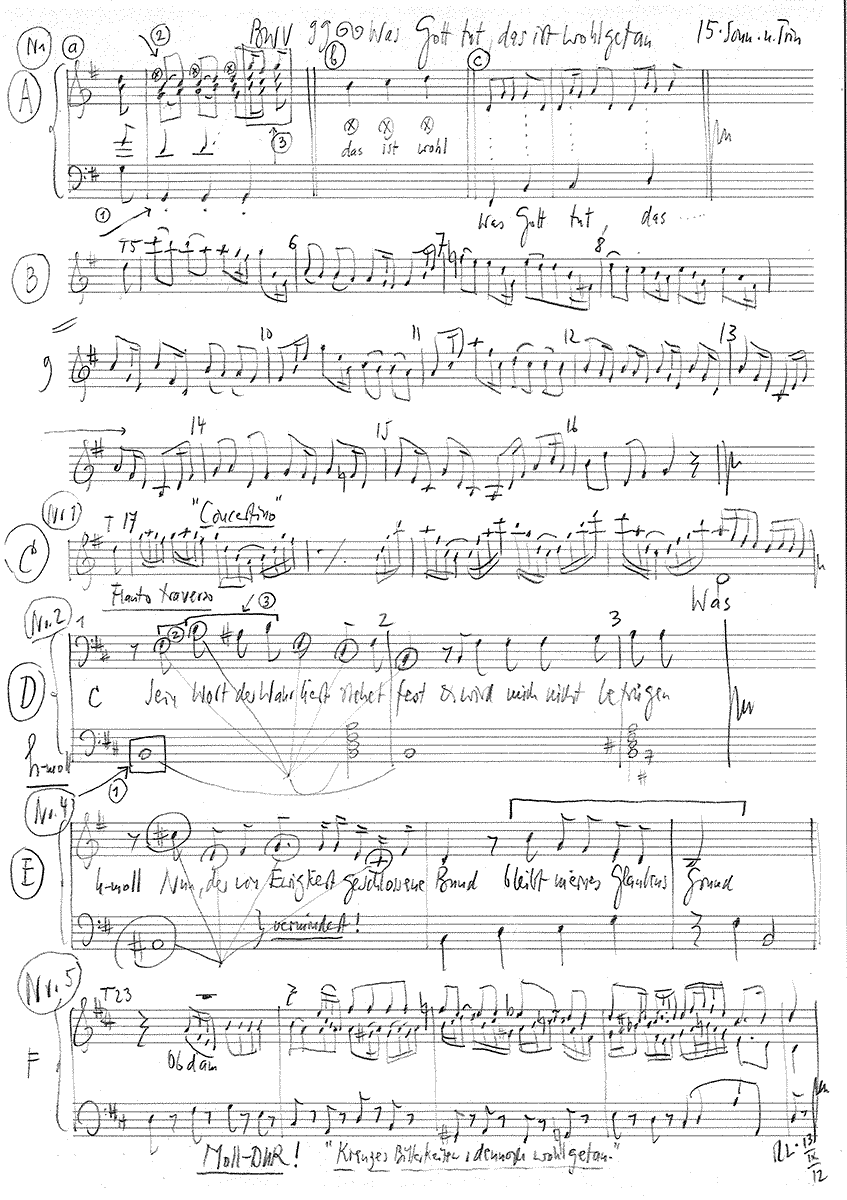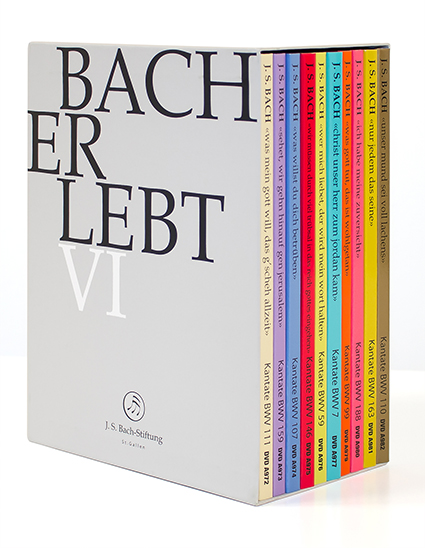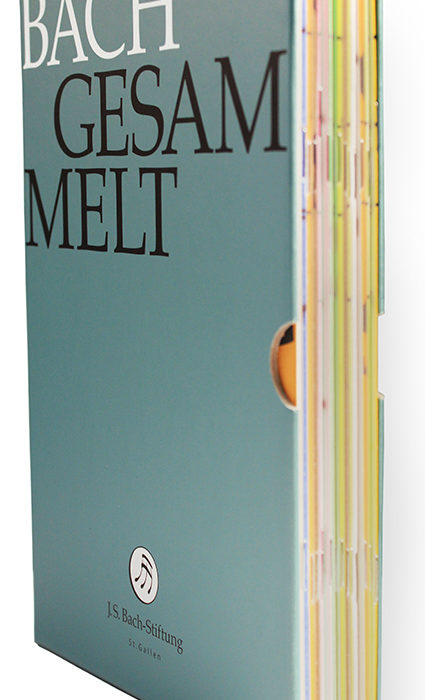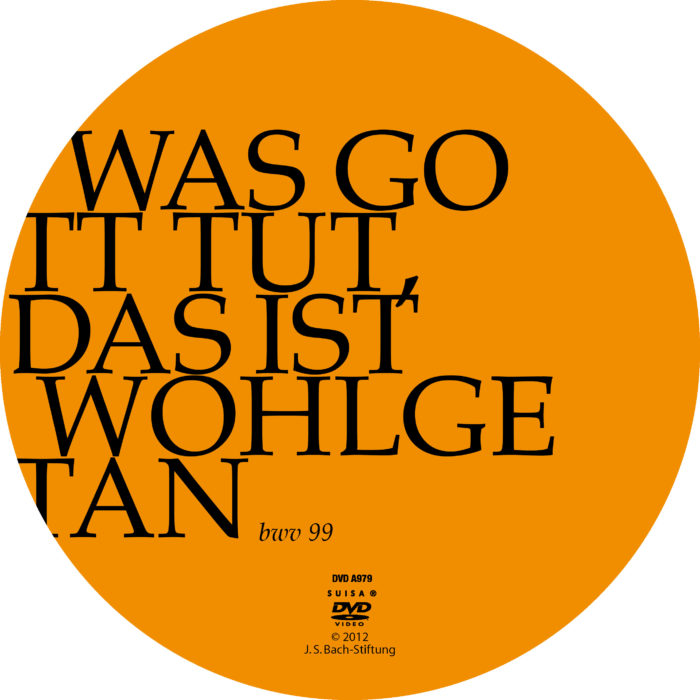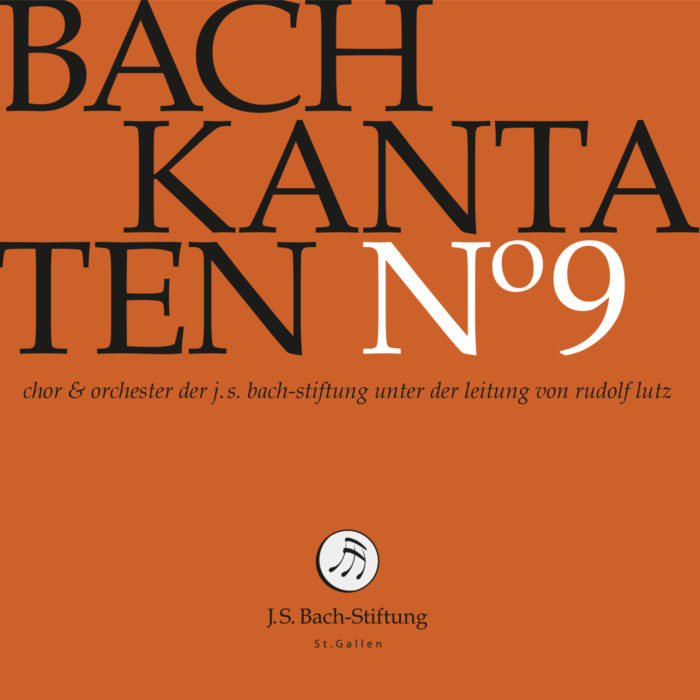Was Gott tut, das ist wohlgetan
BWV 099 // For the Fifteenth Sunday after Trinity
(What God doth, that is rightly done) for soprano, alto, tenor and bass, vocal ensemble, horn, transverse flute, oboe d‘amore, strings and continuo
Written for 17 September 1724, BWV 99 belongs to the substantial chorale cantata cycle of 1724/25, and is one of three cantatas all beginning with the same hymn. While it may be that Bach omitted the organ in movements two to five to underscore the contrast between the traditional chorale in full ensemble sound and the cantata’s freely versed arias and recitatives, this interpretation remains pure conjecture: although the part is marked “tacet” in Bach’s own hand in the source documents, this cannot be dated with certainty and may relate to a later performance.

Would you like to enjoy our videos ad-free? Subscribe to YouTube Premium now...
Workshop
Reflective lecture
Choir
Soprano
Mirjam Berli, Olivia Fündeling, Guro Hjemli, Noëmi Sohn, Noëmi Tran Rediger
Alto
Jan Börner, Antonia Frey, Damaris Nussbaumer, Alexandra Rawohl, Lea Scherer
Tenor
Clemens Flämig, Manuel Gerber, Raphael Höhn
Bass
Fabrice Hayoz, Valentin Parli, William Wood
Orchestra
Conductor & cembalo
Rudolf Lutz
Violin
Renate Steinmann, Dorothee Mühleisen, Christine Baumann, Sabine Hochstrasser, Martin Korrodi, Fanny Tschanz
Viola
Susanna Hefti, Martina Bischof
Violoncello
Maya Amrein, Claire Pottinger
Violone
Iris Finkbeiner
Oboe d’amore
Kerstin Kramp
Bassoon
Susann Landert
Transverse flute
Claire Genewein
Corno
Olivier Picon
Organ
Nicola Cumer
Musical director & conductor
Rudolf Lutz
Workshop
Participants
Karl Graf, Rudolf Lutz
Reflective lecture
Speaker
Barbara Neymeyr
Recording & editing
Recording date
09/14/2012
Recording location
Trogen
Sound engineer
Stefan Ritzenthaler
Director
Meinrad Keel
Production manager
Johannes Widmer
Production
GALLUS MEDIA AG, Switzerland
Producer
J.S. Bach Foundation of St. Gallen, Switzerland
Librettist
Text No. 1, 6
Samuel Rodigast (1649–1708)
Text No. 2–5
Arranger unknown
First performance
Fifteeth Sunday after Trinity,
17 September 1724
In-depth analysis
The introductory chorus is predominantly lively, commencing with a motive of paired slurs that is introduced by the violins. This is then passed to a colourful concertino of transverse flute, oboe d’amore and violin whose variations on this theme are soon interrupted by the entry of the choir. Here, the soprano (doubled by a wind instrument) introduces the hymn melody line-for-line in long tones, before the lower voices enter with their support. The extended movement continues in this charming interplay of various ensemble combinations, evoking a sense of serene trust in God’s guidance.
The bass recitative delivers an expressive declamation that, like many such moments in Bach’s cantatas, melds into an arioso passage: here, most appropriately, on the keyword “change”. And change in the direction of shadowy affect is then introduced in the tenor aria no. 3, whose compositional idea is founded on the textual contrast between uncertainty and fortitude – “Disturb thyself do not, discouraged spirit!” – expressed beautifully by the fleeting, tender timbre of the transverse flute, whose obbligato part unites harmonic tension and stark chromatic passages in supremely elegant phrases. Bach’s ability to disguise his artistry in an efficient composition – much as “hidden sweetness” is concealed in the “cross’s cup” – is given ample proof in this aria.
The ensuing alto recitative paints a striking picture of “pain endured” and daily “torment” despite making a declaration of faith, before duet no. 5 leads these contrasting affects into direct confrontation. In this masterly quintet, Bach reinstates the wind concertino of the opening chorus next to the soprano and alto with transverse flute and oboe d’amore. Here, the motif of repeated notes is equally light and terse, and culminates in a painful sigh. Central to this two-part movement is a virtuoso coloratura, in which the antithetical concepts of “struggle” and “pleasure” meet. This musical insight into the inevitability of suffering as part of the divine plan emerges as the cantata’s key theme, with the interim transition to D major on the words “it is ne’erless rightly done” proving to be a mere battle gained in the ongoing human and musical struggle. All the more powerful then is the closing chorale, in which the return to the G major tonality of the introductory movement happily coincides with the movement’s recapitulation of the hymn’s opening motto: “What God doth, that is rightly done”.
Libretto
1. Chor
Was Gott tut, das ist wohlgetan,
es bleibt gerecht sein Wille;
wie er fängt meine Sachen an,
will ich ihm halten stille.
Er ist mein Gott,
der in der Not
mich wohl weiss zu erhalten;
drum lass ich ihn nur walten.
2. Rezitativ (Bass)
Sein Wort der Wahrheit stehet fest
und wird mich nicht betrügen,
weil es die Gläubigen nicht fallen
noch verderben lässt.
Ja, weil es mich den Weg zum Leben führet,
so fasst mein Herze sich
und lässet sich begnügen
an Gottes Vatertreu und Huld
und hat Geduld,
wenn mich ein Unfall rühret.
Gott kann mit seinen Allmachtshänden
mein Unglück wenden.
3. Arie (Tenor)
Erschüttre dich nur nicht, verzagte Seele,
wenn dir der Kreuzeskelch so bitter schmeckt.
Gott ist dein weiser Arzt
und Wundermann,
so dir kein tödlich Gift einschenken kann,
obgleich die Süssigkeit verborgen steckt.
4. Rezitativ (Alt)
Nun, der von Ewigkeit geschlossne Bund
bleibt meines Glaubens Grund.
Er spricht mit Zuversicht
im Tod und Leben:
Gott ist mein Licht,
ihm will ich mich ergeben.
Und haben alle Tage
gleich ihre eigne Plage,
doch auf das überstandne Leid,
wenn man genug geweinet,
kommt endlich die Errettungszeit,
da Gottes treuer Sinn erscheinet.
5. Arie (Duett Sopran, Alt)
Wenn des Kreuzes Bitterkeiten
mit des Fleisches Schwachheit streiten,
ist es dennoch wohlgetan.
Wer das Kreuz durch falschen Wahn
sich vor unerträglich schätzet,
wird auch künftig nicht ergötzet.
6. Choral
Was Gott tut, das ist wohlgetan,
dabei will ich verbleiben;
es mag mich auf die rauhe Bahn
Not, Tod und Elend treiben,
so wird Gott mich
ganz väterlich
in seinen Armen halten,
drum lass ich ihn nur walten.
Barbara Neymeyr
“In the field of tension between optimistic theology of suffering and sceptical question of theodicy”.
A cultural-historical view of the cantata “Was Gott tut, das ist wohlgetan” (BWV 99)
Three times Johann Sebastian Bach based his cantatas on poetic verses by Samuel Rodigast which begin with the striking statement: “Was Gott tut, das ist wohlgetan”. He chose these verses for the first time in 1724, in his second year as Thomaskantor in Leipzig – as the basis for the cantata BWV 99. And in the following decade he used the text for two other cantatas, which he then continued in different ways after the same chorale verse. The fact that the composer repeatedly set the same text passage to music suggests that he dealt particularly intensively with the central content of the verses, the relationship between the experience of suffering and trust in God. And, as we know, there was plenty of occasion for this in Bach’s own life story.
How can the text of today’s cantata be understood against the cultural-historical background of the time? And in what ways did people at that time and in later epochs react to the existential challenge of suffering? – In my reflection, I now illuminate Bach’s cantata “Was Gott tut, das ist wohlgetan” in the field of tension between optimistic theology of suffering and sceptical theodicy.
Opposites dominate the six stanzas: Negative experiences that might suggest despondency and despair are contrasted with a fundamental hope. The cantata text interprets “accident”, “misfortune”, “plague”, “suffering”, “hardship, death and misery” as “the bitterness of the cross”. They suggest that Christians should see themselves as followers of Jesus – in the sense of Mark’s Gospel: “If anyone would come after me, let him deny himself and take up his cross.” In principle, however, suffering can also provoke quite different reactions: Sadness, resignation and pessimism, even deep existential shock. But the cantata, which seems like a musical sermon, addresses a positive message to the believer: Trusting in a benevolent and almighty God, he is able to wait with “patience” and “confidence” for the moment when his “misfortune” will turn around.
Redemption through fear and anguish
The attitude to life characteristic of Baroque literature has often been described as ‘antithetical’. Although the antithesis as a tension-creating poetic-rhetorical structure lends special urgency to numerous Baroque poems, it is inappropriate to elevate this stylistic figure to the signum of the entire epoch. For what remains unconsidered is the dynamic of a reciprocal conditional relationship between suffering and salvation, which theologically implies more than a simple opposition of this world and the next, of transience and eternity, of death and life.
In the 17th century, there is ample evidence for the Christian assumption of an interdependence of suffering and salvation. And this is supposed to mean: Without suffering and without the transience of everything earthly, there would be no path to God. From a theological perspective, immanence and transcendence are interconnected and refer to each other. Challenges and guilt, pain and death also receive their meaning in the stable order of Christian concepts of salvation. Only probation in the face of fear, anguish, hardship and death promises salvation.
Under Christian premises, patient suffering without hope of salvation would seem pointless. The text of the cantata also expresses such an interdependence: “Whoever esteems the cross unbearable through false delusion/will not be gladdened in the future”. But if the experience of suffering is supported by faith, then even the negativity of life can turn into positivity. The well-known baroque poet and linguist Justus Georg Schottelius writes in his poem “UnglüksLust”: “Whoever bears a misfortune right/can say of great happiness:/Unglük lehret Glückes Kunst/ Bringt zur rechten Himmelsgunst.” (sic!) – The Baroque poet Andreas Gryphius, who was influenced by Christian doctrine and Stoic philosophy, also sees transience, suffering and death as essential prerequisites for salvation and redemption, which in turn require the patient endurance of negative experiences.
But historically, there are other ways than the one highlighted in the cantata to cope with pain and the fear of death: since antiquity, Stoic philosophy has propagated the control of affect by reason and an ethos of wisdom, virtue and steadfastness in the face of the incalculable impositions of fate. This attitude is supposed to enable happiness through peace of mind, through a ‘tranquillitas animi’. Through the steadfastness of his mind (through ‘ataraxia’ and ‘apatheia’), man is able to face the vicissitudes of life with sovereignty, because he has an inner autonomy, even self-sufficiency, which also makes him independent of transcendent instances. Despite pronounced differences between Christian doctrine and Stoic philosophy, there were also influential syntheses in Neo-Stoicism.
However, problematic consequences can also result from one-sidedly absolutised concepts of salvation: Those who regard suffering exclusively as a necessary prerequisite for a future salvation in the hereafter run the risk of thereby weakening their commitment to improving the situation of life in this world. Suffering and hardship are then rashly justified, even interpreted as desirable: as ideal access to eternal bliss – according to the principle: ‘Suffering brings about salvation, and salvation presupposes suffering’. A passive-affirmative attitude to the experience of suffering could even serve as a tried and tested means of enduring the social hierarchies of an absolutist society and its extreme injustices. As long as the misery in the ‘earthly vale of tears’ can be compensated by religious promises of salvation, the suffering of the individual and the political misery in a society can be justified with the supposedly good end in the hereafter. However, time and again socially committed groups within the churches have very successfully taken other, constructive paths …
“God is my light”
The era of the Enlightenment opened up new ways of overcoming suffering: after the experience of the religious wars and in view of the Inquisition, which had led to epidemic persecutions of witches and burnings of heretics, i.e. to the most severe suffering, the Enlightenment thinkers began to question religious norms. They criticised hitherto self-evident traditions and authorities, turned against any dogmatism or even fanaticism and propagated the ideal of tolerance and religious freedom. The progress of civilisation inspired the idea of human autonomy. It followed a resolute orientation towards this world and was determined by an ethos of humanity.
The metaphor of light also underwent a revealing reinterpretation in the ‘siècle des lumières’. In today’s cantata, the I, still completely oriented towards transcendence, declares emphatically: “God is my light”. The Enlightenment thinkers, on the other hand, speak of the light of reason that should illuminate the abysses of ignorance or dark superstition. The opponents of the reason-oriented Enlightenment, however, regarded the light of reason as a mere reflection of the divine light. This reinterpretation of the metaphor of light also determines the negative image of man that Goethe has the Mephisto figure formulate in the “Prologue in Heaven” of his Faust drama: “He would live a little better, / Had you not given him the glow of heavenly light; / He calls it reason and needs it alone, / Only to be more animal than any beast” (v. 283-286). – The reproach with which Mephisto confronts the Lord here corresponds to the radical thesis formulated by the English philosopher Hobbes in the words of the Roman comic poet Plautus: “homo homini lupus”: man is a wolf to man. Freedom and equality do not automatically mean that the third postulate of the French Revolution has already been realised: fraternity. This requires ethical convictions that manifest themselves in practical solidarity with the poor, the weak and the helpless.
How much suffering people can experience at the hands of their fellow human beings without a divine authority appearing to put a stop to it is shown not least by the catastrophes of the world wars and the horrors of the Holocaust. In addition, there is the suffering due to diseases or natural disasters. For example, the huge earthquake in Lisbon in 1755, 5 years after Bach’s death, challenged intellectuals such as Voltaire, Rousseau and Kant at the time to come up with their own answers to the question of how the idea of divine omnipotence and goodness can be reconciled with the possibility of natural disasters that can destroy entire cities and claim thousands of victims.
Over the centuries, the gigantic scale of all suffering has repeatedly become the subject of controversial discussions in theology, philosophy and literature, namely through the theodicy question. In Georg Büchner’s revolutionary drama Danton’s Death, the philosopher Payne declares: “Why do I suffer? This is the rock of atheism”. – How can a God imagined as omnipotent, omniscient and benevolent allow suffering and evil in the world? – Are there not numerous reasons to doubt the statement: “What God does is well done”?
The best of all possible worlds
In 1710, 14 years before Bach’s cantata, the philosopher and polymath Leibniz responded to the problem of theodicy by unfolding his famous thesis of the ‘best of all possible worlds’. Leibniz, however, was by no means of the opinion that the existing world was the optimum that could not be surpassed in every respect. Rather, it was important for him to justify the necessary correlation of good and bad through reflection in the Essai de Théodicée: Leibniz believed that some good things essentially presuppose the existence of negative things. The real world is the best in the sense that God could not have realised the good in it with a lesser degree of evil. At the same time, Leibniz thinks of the “best of all possible worlds” in dynamic terms, granting it maximum diversity and potential for development.
More than a century later, the philosopher Arthur Schopenhauer, with his metaphysical pessimism, refers to the theodicy discussion initiated by Leibniz – and does so in provocative polemics. He pays tribute to Leibniz with subversive esprit by conceding “to theodicy, this methodical and broad development of optimism”, only the “merit” “that it later gave rise to the immortal ‘Candide’ of the great Voltaire”, indeed he even sees Voltaire’s Candide as confirming Leibniz’s view that “the bad sometimes brings about the good”. The satirical explosive power of this ironic homage is revealed against the background of Schopenhauer’s critique of optimism in his main work, The World as Will and Imagination: Here he describes the world as a “playground of tormented and frightened beings, which exist only because one consumes the other”. According to Schopenhauer, life is “essentially a multiform suffering and a thoroughly unhappy state”, to which “complete non-being […] would be decidedly preferable”. For “every human life”, “viewed as a whole, shows the characteristics of a tragedy”: through “the unfulfilled wishes, the thwarted aspirations, the hopes mercilessly crushed by fate, the unfortunate errors of the whole life, with the increasing suffering and death at the end”. In a sententious point, Schopenhauer declares: “A happy life is impossible: the highest that man can attain is a heroic course of life”. – In contrast to Leibniz, Schopenhauer sees the world not as the best, but as the worst of all possible worlds: “this world [is] set up in such a way as it had to be in order to be able to exist with exact necessity: but if it were even a little worse, it could no longer exist”. He harshly condemns optimistic world views – as “bitter mockery of the nameless sufferings of humanity”.
Voltaire made an important contribution to this polemically sharpened debate with his novel Candide (1759), which takes the optimism of the characters to absurdity in the medium of literary satire: Here, the unshakable optimism of the Leibniz follower Pangloss and his trusting, naïve pupil Candide is put to the test by an almost grotesque profusion of misfortunes and catastrophes, including the Lisbon earthquake, without the characters being willing to revise their optimistic worldview: “‘Well, my dear Pangloss,’ Candide said to him, ‘when you were hanged, dissected, beaten, and made to row in the galley, did you still believe that everything in the world was arranged for the best? ‘ – ‘Yes, I am still of the same opinion,’ was Pangloss’s reply; ‘because, after all, I am a philosopher, and it is therefore impossible for me to revoke my words, all the less so because Leibniz cannot be wrong and, moreover, there is nothing more beautiful in the world than the prestablished harmony’.
Bach’s forward and backward-looking perspectives
Friedrich Nietzsche then formulates even more radical perspectives in his essay “Menschliches, Allzumenschliches” (1878/86): He considers the terms “optimism and pessimism” already obsolete and asks the rhetorical question: “why on earth should anyone want to be an optimist if he does not have to defend a God who must have created the best of worlds if he himself is the good and perfect, – but which thinking person still has need of the hypothesis of a God?” For Nietzsche, “it is obvious that the world is not good and not evil, let alone the best or the worst, and that these terms ‘good’ and ‘evil’ only make sense in relation to human beings”, that is, they are conditioned by perspective interpretation. Nietzsche’s own answer in his late writing “Ecce homo” then consists dialectically in “the highest affirmation”, in an “affirmation without reservation, to suffering itself, to guilt itself, to everything questionable and alien in existence itself…” And according to Nietzsche, it is precisely this “last, most joyful, most exuberant yes to life” that testifies to the deepest insight, not at all to naivety. Nietzsche himself was intensely familiar with suffering, as numerous letters testify.
A letter from the 25-year-old Nietzsche reveals his special relationship to Bach: “This week I have heard the divine Bach’s St Matthew Passion three times, each time with the same feeling of immense amazement. Those who have completely forgotten Christianity really hear it here like a gospel; this is the music of the negation of the will, without the memory of asceticism.” – Nietzsche adds to this confession, which is linked to Schopenhauer’s perspectives, in an aphorism in his essay “Menschliches, Allzumenschliches”: “As listeners” to Bach’s “music, we feel as if we were present when God created the world. That is, we feel that something great is in the making here, but is not yet: our great modern music”. For Nietzsche, Bach “stands at the threshold of European (modern) music, but looks around from here to the Middle Ages.” –
Although the answers to the existential challenge of suffering are far apart in the spectrum of worldviews, Bach’s passions and cantatas offer many people to this day a special space for meditation and resonance….
Literature
– Giorgio Colli, Mazzino Montinari (eds.), Friedrich Nietzsche: Sämtliche Kritische Studienausgabe in 15 Volumes, Munich/Berlin/New York 1980
– Thomas Hobbes, Of Man, Of the Citizen, Hamburg 1994 (Philosophische Bibliothek 158)
– Wolfgang Freiherr von Löhneysen (ed.), Arthur Schopenhauer, Complete Works, Darmstadt 1976-1982
– Wolfram Mauser, Poetry, Religion and Society in the 17th Century. The Sonnets of Andreas Gryphius. Munich 1976
– Barbara Neymeyr, Aesthetic Autonomy as Abnormality. Critical Analyses of Schopenhauer’s Aesthetics in the Horizon of his Berlin/New York 1996 (Sources and Studies in Philosophy vol. 42).
– Barbara Neymeyr, Jochen Schmidt, Bernhard Zimmermann (eds.), Stoicism in European Philosophy, Literature, Art and Politics. A Cultural History from Antiquity to Modernity. 2 vols. Berlin/New York
– Karl Pörnbacher, Gerhard Schaub, Hans-Joachim Simm and Edda Ziegler (eds.), Georg Büchner, Werke und Briefe. Munich edition, 6th ed. Munich 1997
– Erich Trunz (ed.), Goethe’s Commentary and Index. Hamburg edition in 14 volumes. 13th ed. Munich 1986
– Voltaire: Complete Novels and Tales in Two Volumes. German by Ilse Lehmann. With introduction by Victor Klemperer. Leipzig 1948. licensed edition Wissenschaftliche Buchgesellschaft Darmstadt
– Christoph Wolff, Bach’s Leipzig Church Cantatas: Repertoire and Context, in: Christoph Wolff (ed.), The World of Bach Cantatas. With a foreword by Ton Koopman. Vol. III: Johann Sebastian Bach’s Leipzig Church Cantatas. Stuttgart/Weimar/Kassel 1999.
This text has been translated with DeepL (www.deepl.com).



